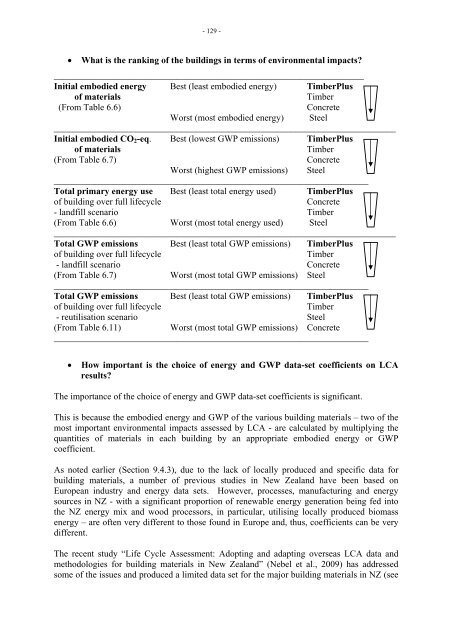Environmental Impacts of Multi-Storey Buildings Using Different ...
Environmental Impacts of Multi-Storey Buildings Using Different ...
Environmental Impacts of Multi-Storey Buildings Using Different ...
You also want an ePaper? Increase the reach of your titles
YUMPU automatically turns print PDFs into web optimized ePapers that Google loves.
- 129 -• What is the ranking <strong>of</strong> the buildings in terms <strong>of</strong> environmental impacts?____________________________________________________________________Initial embodied energy Best (least embodied energy) TimberPlus<strong>of</strong> materialsTimber(From Table 6.6)ConcreteWorst (most embodied energy) Steel___________________________________________________________________________Initial embodied CO 2 -eq. Best (lowest GWP emissions) TimberPlus<strong>of</strong> materialsTimber(From Table 6.7)ConcreteWorst (highest GWP emissions) Steel_____________________________________________________________________Total primary energy use Best (least total energy used) TimberPlus<strong>of</strong> building over full lifecycleConcrete- landfill scenario Timber(From Table 6.6) Worst (most total energy used) Steel___________________________________________________________________________Total GWP emissions Best (least total GWP emissions) TimberPlus<strong>of</strong> building over full lifecycleTimber- landfill scenario Concrete(From Table 6.7) Worst (most total GWP emissions) Steel_____________________________________________________________________Total GWP emissions Best (least total GWP emissions) TimberPlus<strong>of</strong> building over full lifecycleTimber- reutilisation scenario Steel(From Table 6.11) Worst (most total GWP emissions) Concrete_____________________________________________________________________• How important is the choice <strong>of</strong> energy and GWP data-set coefficients on LCAresults?The importance <strong>of</strong> the choice <strong>of</strong> energy and GWP data-set coefficients is significant.This is because the embodied energy and GWP <strong>of</strong> the various building materials – two <strong>of</strong> themost important environmental impacts assessed by LCA - are calculated by multiplying thequantities <strong>of</strong> materials in each building by an appropriate embodied energy or GWPcoefficient.As noted earlier (Section 9.4.3), due to the lack <strong>of</strong> locally produced and specific data forbuilding materials, a number <strong>of</strong> previous studies in New Zealand have been based onEuropean industry and energy data sets. However, processes, manufacturing and energysources in NZ - with a significant proportion <strong>of</strong> renewable energy generation being fed intothe NZ energy mix and wood processors, in particular, utilising locally produced biomassenergy – are <strong>of</strong>ten very different to those found in Europe and, thus, coefficients can be verydifferent.The recent study “Life Cycle Assessment: Adopting and adapting overseas LCA data andmethodologies for building materials in New Zealand” (Nebel et al., 2009) has addressedsome <strong>of</strong> the issues and produced a limited data set for the major building materials in NZ (see
















